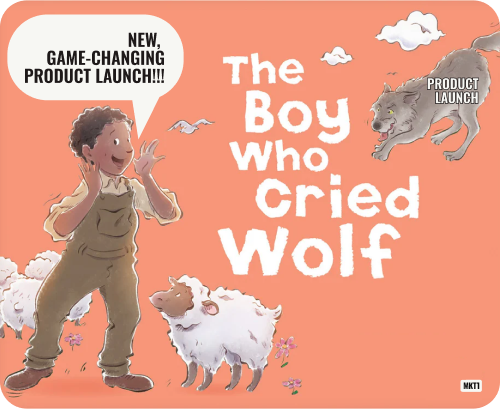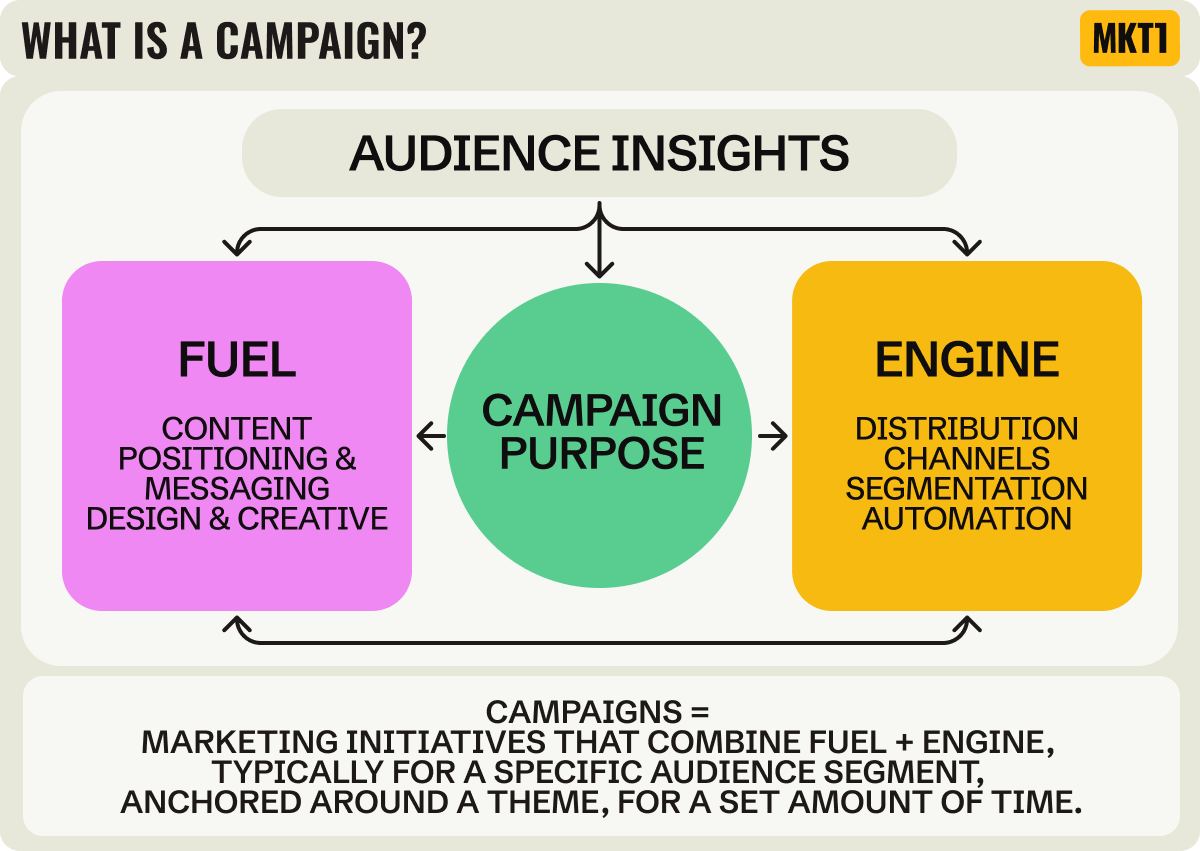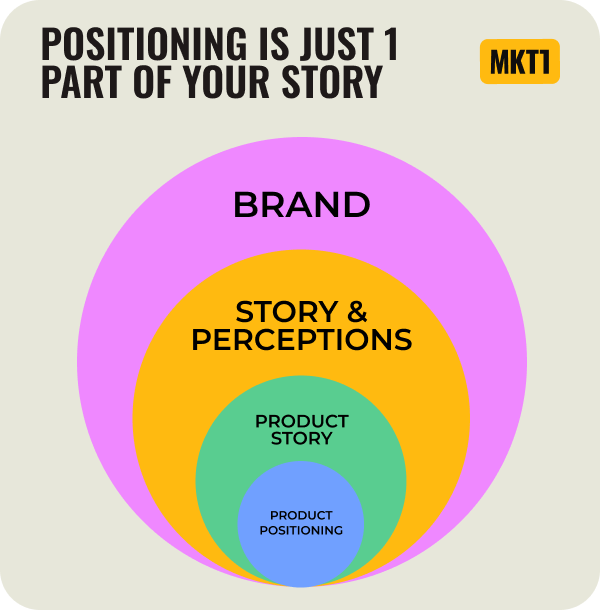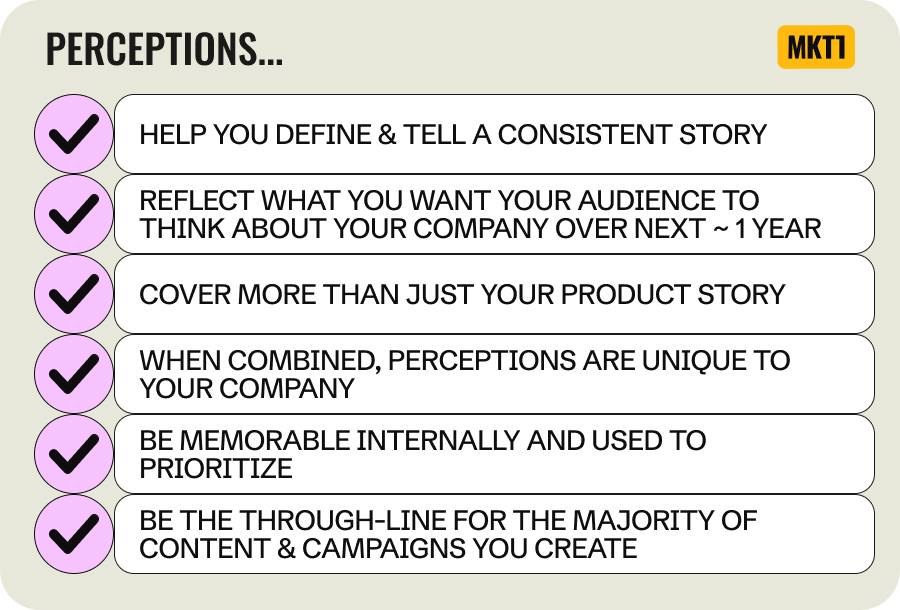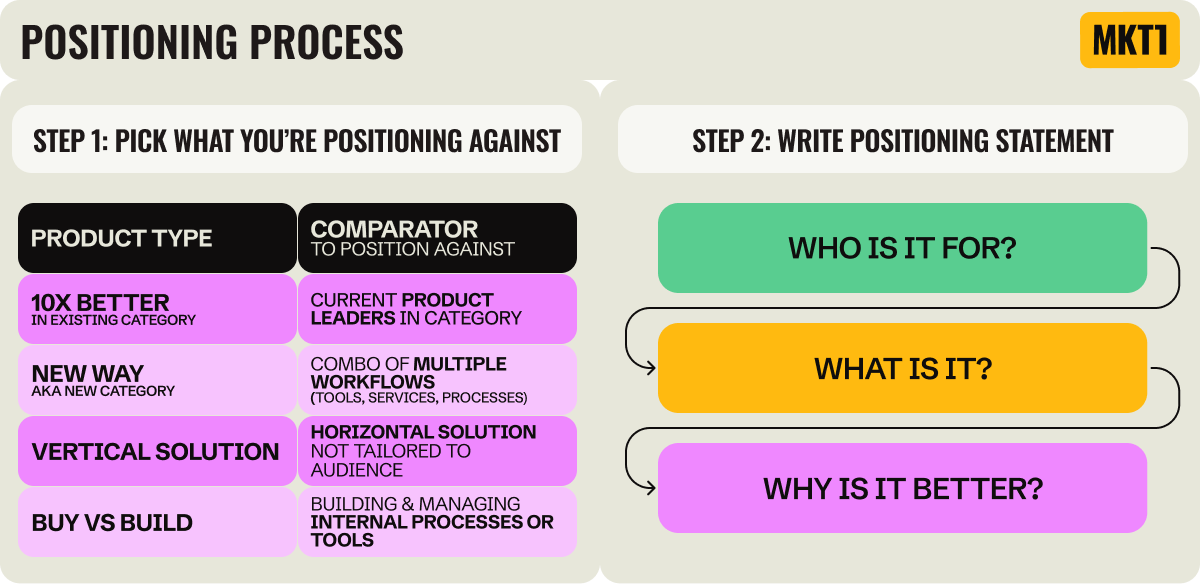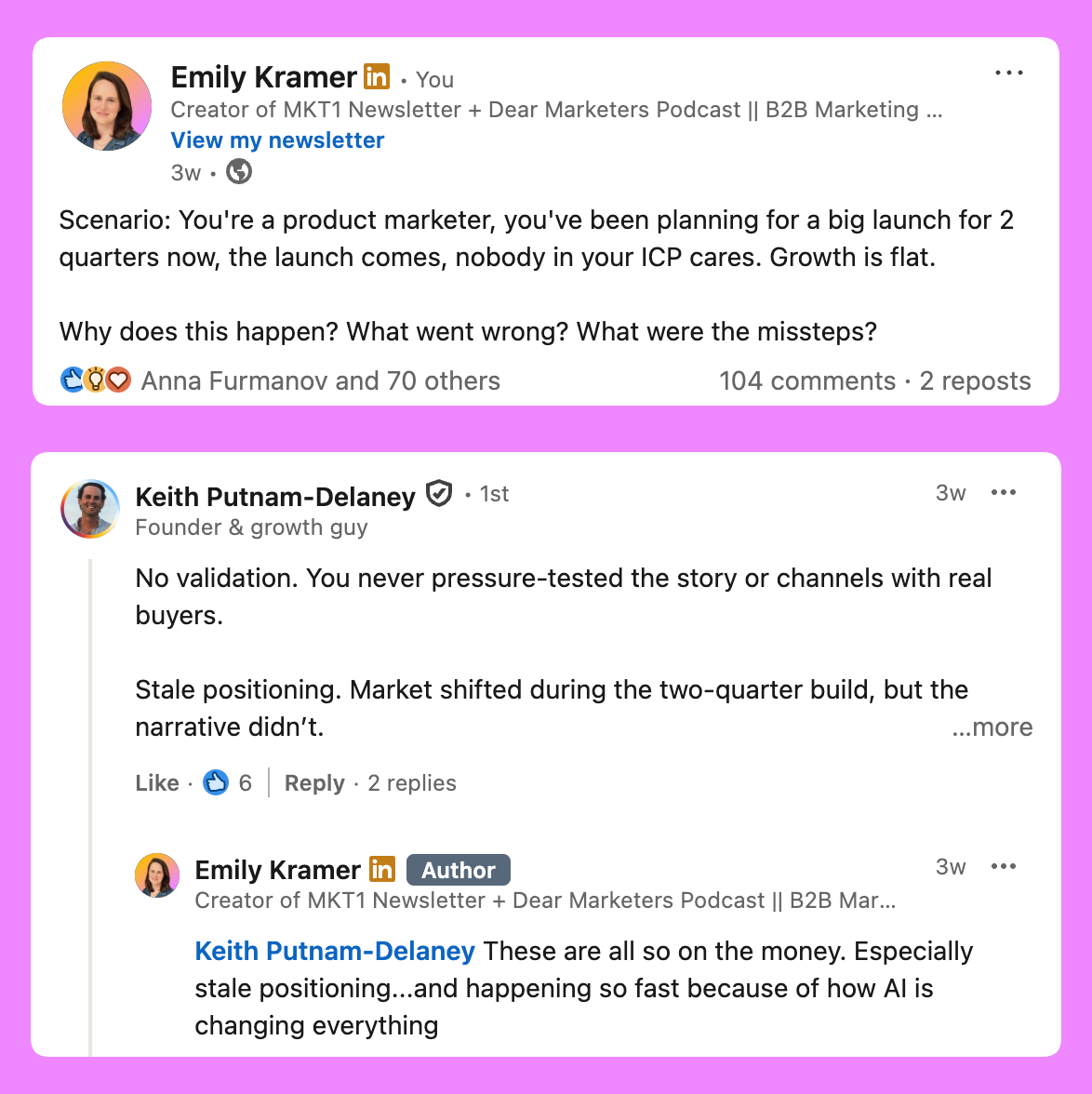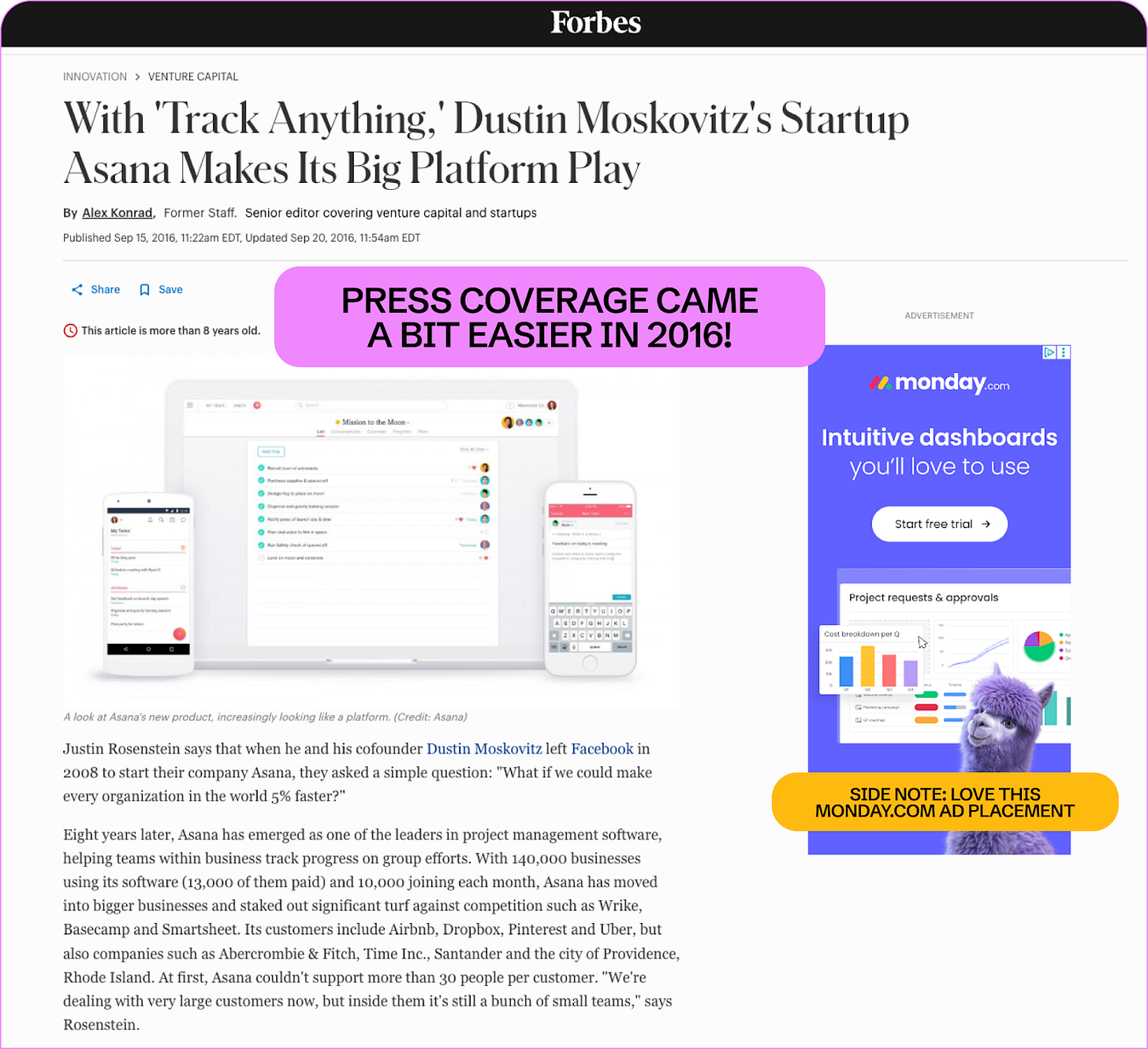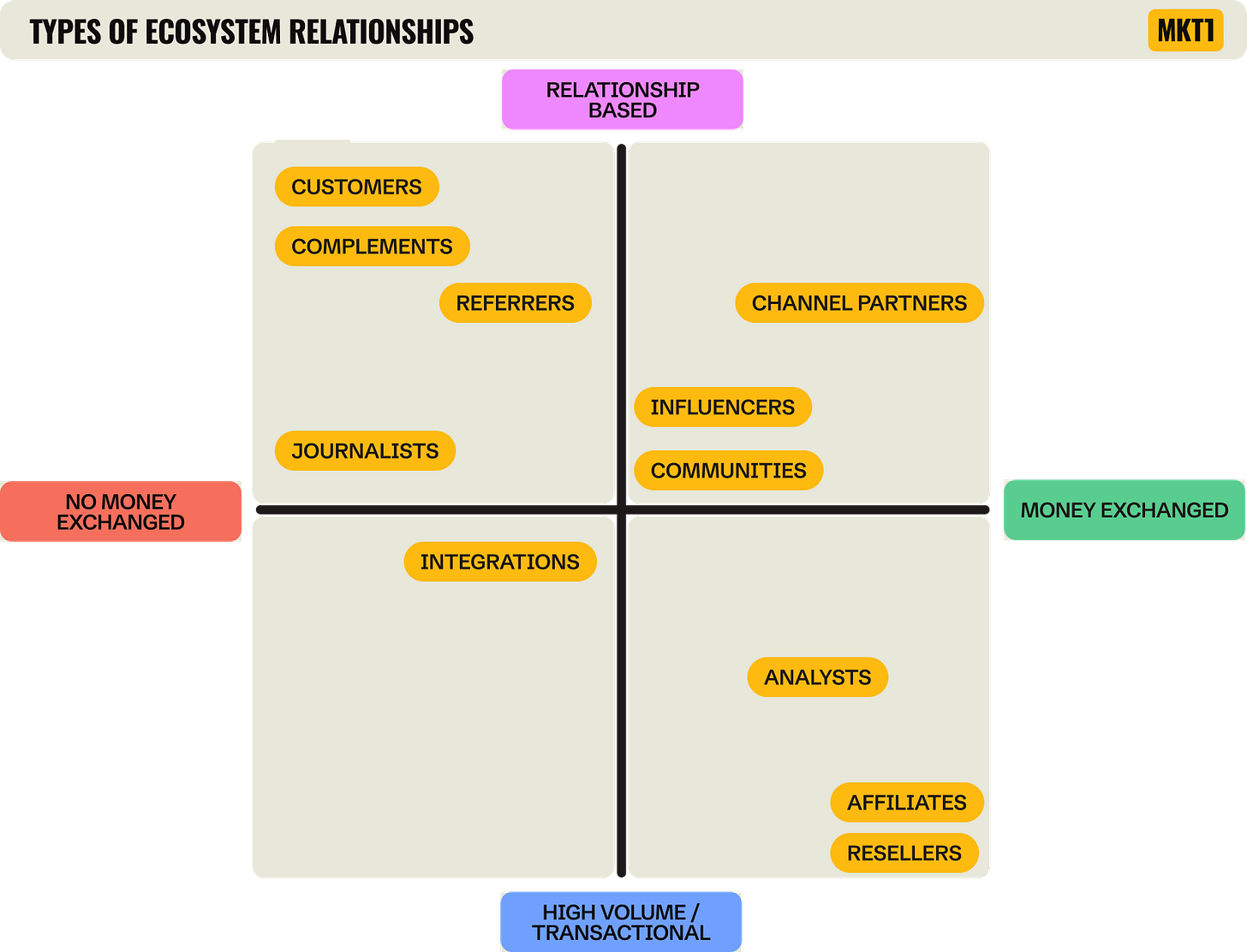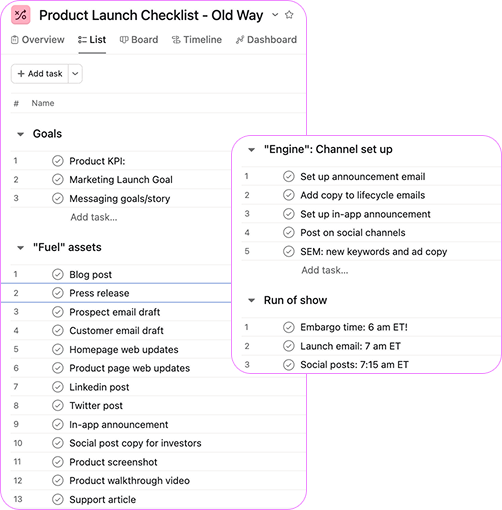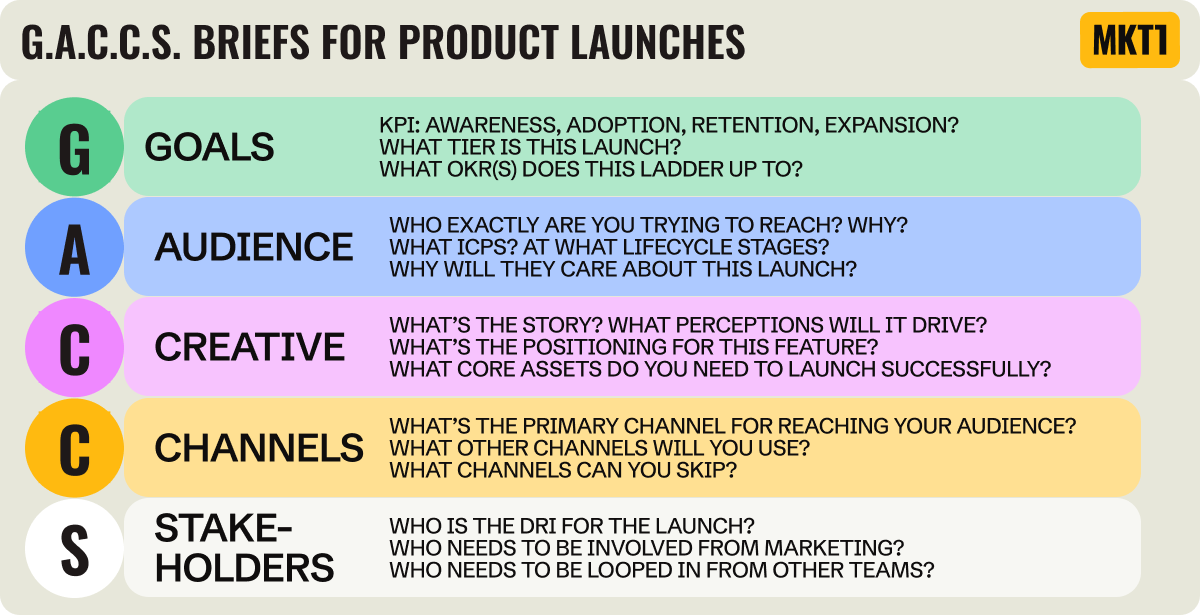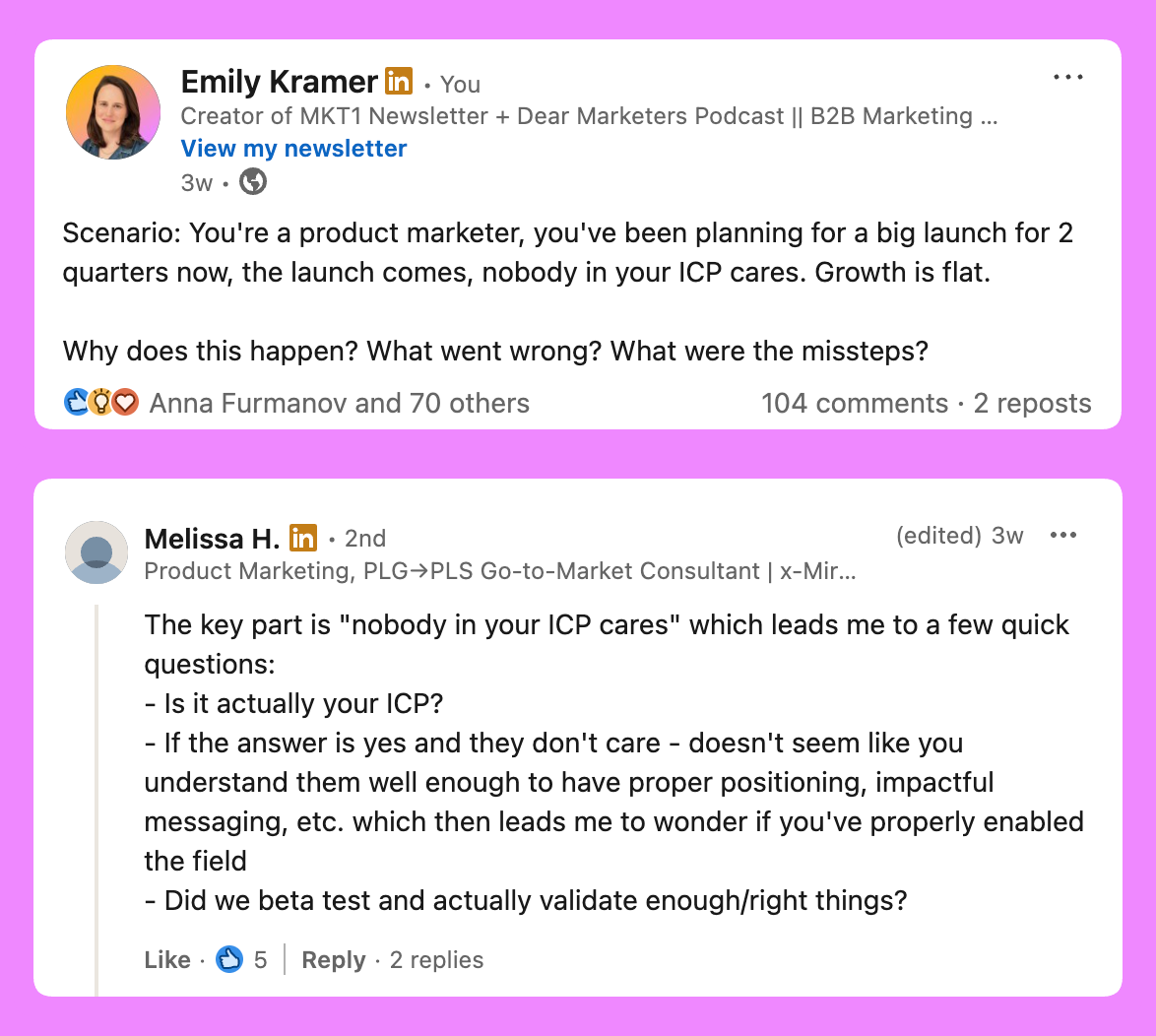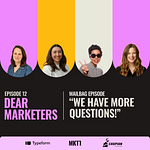🎙️ This free edition of MKT1 newsletter covers Season 1, Episode 11 of “Dear Marketers with Emily Kramer & Friends” podcast, brought to you by Typeform, Framer & RevenueHero.
Listen or watch the podcast on Spotify, Apple Podcasts, or YouTube. Plus read the full newsletter below for an even deeper dive on the topic. The newsletter is meant to augment the podcast, not just recap it.
Today’s question:
“Dear marketers, In the olden days, product launches used to feel like glorified checklists. You get the company announcement out, stand up a new landing page, deploy your email comms. But I think we’re all realizing that the one-time launch is a miss and it’s important to build a framework to sustain momentum over time. So my question is: How should we be thinking about product launches in 2025? Not just as a single moment, but as a steady drumbeat and system.”
– Krystal Barghelame, Head of Marketing at Guideline
Dear Krystal and Marketers, I remember that simpler time when product launches were the drumbeat of a marketing strategy. I sent a few tech journalists my launch blog post, they covered the announcement, and I was off to the races—as you said. I got a demo video made, got some customer quotes, some details from the PM, and then remixed these things across a clear list of channels and the launch drove top of funnel traffic and upsells. Okay, it maybe wasn’t that simple, but it definitely used to be easier to get bang for your buck on a product launch.
If you don’t remember those days, honestly, it may be for the best. Otherwise, you might expect way too much from a Product Hunt launch or a story in tech press about a new feature. In 2025, product launches don’t really work the way they used to—unless you are one of 5–10 very hot AI companies and everyone is tracking your every move.
Why? Because it’s easier than ever to ship features, create content, and hit publish on the same tired checklist.
The channels that once delivered your message on a platter to your audience are noisier, more crowded, and far less reliable.
Journalists don’t cover feature launches because there just aren’t as many journalists.
Product categories are more crowded, it’s easier to build software, and go toe to toe with competitors on features. And even great products get lost in the shuffle.
So if you’re still running your old launch playbook, it’s time for a reality check. Today, your audience doesn’t care what’s new, they care what’s valuable. And not every feature is launch-worthy. Some updates deserve big-bet campaigns. Others? A quiet change-log mention or lifecycle email will do.
In this newsletter and podcast:
My co-hosts, Devon Watts (Head of Product Marketing and Partner Marketing at Mercury), Jenny Thai (Head of Content at Vanta), and have done product launches at: Asana, Mercury, Vanta, Carta, Anrok, Clearbit, Dropbox, Microsoft, and more.
This newsletter is focused on 5 bad habits marketers need to break when doing product launches in 2025:
Treating your product roadmap as your marketing roadmap
Creating your launch story in a vacuum
Thinking press will save you
Substituting launch checklists for strategy
Not getting aligned internally
The podcast covers the ins and outs of product launches:
Devon, Jenny, and I remember the simpler launch times when we worked at Asana
Then we move back to reality, and break down what you need to do for a product launch today
Thanks to our Dear Marketers sponsors:
I vet each partner personally and these are genuine recommendations (even though yes, we do get paid for this).
Typeform: Typeform isn’t just for creating beautiful forms and collecting responses, you can summarize answers with AI, embed video, enrich data, route leads, and connect with 300+ tools. You can even use it to get customers insights before a launch or to build a beta list—we use it at MKT1 and love it.
🎁Offer: Use code MKT1 to get 20% off their annual growth plan.
__
Framer: A no-code website builder that feels like a design tool. With new AI layout generation, built-in analytics, and vector drawing, it’s even easier to build, test, and launch sites faster.
🎁 Offer: Apply to their startup program and get their $900 Launch Plan free for a year at framer.com/startups.
__
RevenueHero: Don't lose your best prospects to complicated scheduling. Use RevenueHero to auto-enrich and route inbound leads, or to add "magic links" to your outbound emails. It’s used by Clay, Sendoso, and Freshworks.
🎁Offer: Mention MKT1 and get 15% off if your company buys before 9/30/25.
Watch Episode 11 here, or keep reading for the full newsletter.
“Everything can come crashing down on you if you haven't realized some of the changes that have occurred. If your launches and campaigns aren’t successful, one of the problems might be that you’re not doing marketing like it’s 2025. You're not understanding the channels that work today. You're not able to segment down to specific ICPs. You're not understanding how to stand out through authentic voices and your ecosystem—because people don't want just generic, AI-written content about your product.
If you are behind on what’s going on right now, it is going to show when you get to a launch. Product launches are where things come tumbling down if you’re stuck in the past.” – Emily Kramer (that’s me) in Episode 11
You can also listen to the podcast on Spotify or Apple Podcasts.
The 5 bad product launch habits marketers need to break
Kramer, Episode 11: “So why does the old way no longer work?
Devon: “Partly because of evolution of the channels. There’s less interest in covering product launches. There’s also just less traditional media literally in existence now than there was 10 years ago. There’s email saturation due to AI generation of outbound sequences. It’s harder to break through via these traditional channels that we’re used to using for product launches.”
🚫 Bad habit 1: Product roadmap = marketing roadmap
Back to the olden days for a second: I used to sit down and map out all our product launches for the year and then plan our marketing calendar around them. But now, not every feature or update deserves a full-blown launch. And even the launches that do matter shouldn’t automatically become the centerpiece of your marketing calendar.
“I’ve been on teams where we get really caught up in just launching every individual feature that product ships. And then we miss the opportunity to bundle several features together to tell that larger story and show that larger value to customers.” – Jenny Thai in Episode 11
I don’t feel like this take should be particularly controversial, but I find that a lot of teams are still holding on to the old way of doing things. So say it with me slowly: Not every feature needs a full product launch (I hope your exec team heard that too).
When you treat every release like it needs its own campaign, you burn out your team, overwhelm your audience, and drain your ecosystem partners’ willingness to amplify your message. Worse, when your whole calendar revolves around launches, you miss the opportunity to run higher-impact campaigns built around what your audience actually cares about—not just what’s shipping next.
✅ Break the habit: Build your calendar around audience needs, not ship dates
Ask yourself: Is this product release more important than the other campaigns we could be running right now?
“Big projects and product launches are just one type of campaign. The question is, is this a big campaign? Is this a big initiative? Is this something that can change the trajectory of your company? You're not comparing launches with other product launches, you should be comparing them to other campaigns. Big campaigns are going to require all hands on deck across marketing, potentially other teams and say: Is this worth doing in comparison to these other types of initiatives?” – Kramer in Episode 11
Think of product launches as one type of marketing campaign. Ask: Is this moment more important than other campaigns we could run?
Marketing campaigns = marketing initiatives that combine both fuel and engine, typically for a specific audience segment, anchored around a theme, for a set amount of time. Product launches, demand gen plays, new brand or messaging pushes, ABM initiatives, and events can all be “campaigns.”
Fuel = content, creative, messaging
Engine = channels, segmentation, routing
Once you start looking at product launches this way, it becomes clear that some of the smaller and even medium-sized launches aren’t worth it on their own. They are best bundled with other features, or dramatically limited in scope (minor website updates, support article, minor mentions in enablement content).
Instead of letting launch timing dictate your campaign schedule, prioritize high-impact themes based on what your audience cares about, what will actually move pipeline, and what supports your broader narrative.
After you make your big-bet campaign calendar, slot in launches that support those stories—not the other way around. If you decide the product release doesn’t need a full launch, you can bundle it with other features, or simply fold it into your existing content and messaging (more on this in the next section).
“If you’re truly creating a system, then it doesn’t start and end with the launch. It’s integrated. These products, stories, moments, improvements and stuff are integrated into your story and you’re consistently driving top of funnel, mid funnel, and down funnel growth.” – Devon Watts in Episode 11
Use product launch tiers to right-size your efforts
“Aligning on the launch tier helps prevent crying tears later.” – Jenny Thai with the soundbite
I love using tiers to set parameters for marketing efforts. When it comes to product launches, use tiering to determine how much effort to invest. Here’s to set product launch tiers:
Tier 1 launches are your huge launch efforts (likely 1–2 a year, no matter the size of your company). You are pulling out all the stops and likely keeping the drumbeat of this launch going for weeks if not months to come.
Tier 2 launches are your medium launch efforts (likely 1 a quarter). You are attempting to make a splash but maybe for a smaller segment of your audience, or just one funnel/lifecycle stage.
Tier 3s are your tiny “launches,” which usually just require updates to all of your content (web, enablement, support, etc). These are less “announcementy” in nature.
Pro tip: You can (and probably should) bundle multiple launches together to make them worthy of a Tier 1 or Tier 2 effort. Since you’re likely not aiming for exclusive, hot-off-the-press media coverage, this approach is more feasible than it used to be—you can share “news” long after something actually was released.
“It doesn’t need to be that you launch everything the day it is shipped. You need to be talking about your product features in a drumbeat and there’s lots of ways to do that, which don’t necessarily center on just ‘today’s the day.’” – Kramer in Episode 11
Paid subscribers: We of course have a product launch brief & plan template here.
🚫 Bad habit 2: Thinking about your launch story in a vacuum
Kramer: “People think a lot about bundling product launches, but they don’t necessarily think about bundling stories. So when Jenny says it’s all part of the same song, the song is not just product launches, the song is really the song of your company.
And so if you think this product announcement is fuel for a story, well what other fuel can we use? Can we combine it with something else that will make it go even further? And so you’re bundling not just products together, but you’re bundling all different types of fuel. And that's how you have to think about this in 2025.”
Jenny: “It’s like wine and cheese pairings. Wine is your product, cheese is your content.”
Too many teams treat launches like standalone events, instead of part of their broader marketing strategy and brand narrative. When a launch happens in isolation—disconnected from other campaigns or messaging—you miss a huge opportunity to reinforce positioning, tell a cohesive story, and build momentum. Even worse, it can make your product feel like just another “me too” feature, instead of something that actually stands out.
✅ Break the habit: Treat launches as part of your broader narrative
“When I’ve worked on product launches with PMM counterparts, I think the thing that sometimes feels missing—both externally for your audience and then internally for your collaborators—is just that larger context, right?” – Jenny Thai in Episode 11
A launch is part of your story, not the only story
Each launch should be part of your ongoing narrative and connected to your broader go-to-market strategy.
Launches often work best when they’re paired with another story: You can use launches as a forcing function to kick off or amplify other major moments—like fundraising, rebrands, events, or data releases—or vice versa.
To get full value from everything you’ve built, you need to tell that story consistently—not just in big splashy moments, but through a steady drumbeat of messaging across channels.
This goes hand-in-hand with folding launches into your broader campaign strategy. If you’re thinking about how launches fit into your company narrative, you’ll have an easier time building a campaign calendar that integrates and amplifies your product launch stories.
“I’ve seen success bundling launches with a data report. Use the insights from the research to paint the picture of what the problem is and then you position the new feature.” – Jenny Thai in Episode 11
Connect launch stories to your perceptions
“It’s important to remember there are layers of messaging. You are gonna want everything to ladder up to that key company story and at least one of the key perceptions you’re trying to drive.” – Devon Watts in Episode 11
Perceptions are the high-level tenets of your story: what you want your audience to repeat back to you. They anchor your broader narrative and guide the stories you tell across your market efforts.
Most of your “fuel” (content + creative) should ladder up to a small set of 2–3 key perceptions that last 6 to 12 months. More on perceptions in this podcast episode.
Product launch messaging should nest under these perceptions, not tell a totally separate story. What you stand for is way more memorable this way.
Here’s an example:
Perception: [Company name] helps me become an expert on outbound strategy.
Product launch narrative: Our new KPI benchmarking product shows how your outbound emails perform against industry standards.
Product launch content: A benchmark report tied to the launch, with messaging about how if you purchase the product you’ll get more tailored benchmarks.
Write positioning statements for each launch
“Doing positioning for the specific thing that you are launching is a huge unlock. A lot of people will write the ideal press headline before a launch. But launches aren’t built around this press cycle anymore. So to me, it’s not write the ideal headline, it’s write the positioning for the new product.” – Emily Kramer in Episode 11
You should write overall positioning, and then write positioning for all your major products and audiences.
You should write positioning for any major product at the time of launch. Plan to evolve it over time, just like your company-level positioning.
Reminder: Perceptions help you tell your overall story, positioning is just part of that overall story.
Positioning should start with: What is the alternative or comparator your audience would use? Then you need to clearly explain what your product is, who it’s for, and why it’s better than that alternative. Here’s the MKT1 positioning guide.
Let’s keep going with the example of launching a KPI benchmarking product:
Comparator: Gathering benchmarks manually that don’t reflect your ICP or business model
Who is it for? BDR leaders at venture-backed startups
What is it? A benchmarking tool to evaluate outbound campaign performance
Why is it better? Get relevant, segment-specific benchmarks for every campaign automatically
Reminder: It’s possible you could write positioning for a feature, and then have to update the positioning before you launch it. The market can shift rapidly (especially if you are an AI company) and your positioning can quickly become stale, as Keith mentioned on my LinkedIn post:
🚫 Bad habit 3: Thinking press will save you
“You used to be able to build this launch checklist. You’d write that blog post, you’d pitch that press person, and maybe you’d throw it on Product Hunt. And, bing, bang, boom, signups, usage galore. Everybody’s using it. Not entirely true, but you could get traction on a lot of those channels. You could get press even for medium to large-sized product launches. And I feel like people cared about product news and that it was a really great way to get users re-engaged and excited. But for most companies, I just don’t see that happening these days.” – Kramer in Episode 11
A decade ago, you could count on tech press to cover a new product or even a major feature. The PR strategy often was the launch strategy. But those days are gone.
Unless you’re bundling your launch with something bigger—like funding, trend data, or a category-defining moment—press isn’t going to save your launch. And even if you do get coverage, it likely won’t move the needle on traffic or adoption. It might help with recruiting or investing, but even that will likely be limited.
Relatedly, we used to minorly leverage our ecosystem of investors, customers, and even partners to amplify the press story, sometimes even participating in interviews with journalists. Now, these ecosystem players can often amplify your message more broadly than press can.
“Old channels are still relevant, but you just gotta do it differently. I think there’s still room for press and earned media, but you’re not gonna get that for every little feature. It’s really just probably gonna be for your tier ones, if that. And to make that happen, you gotta bundle [your product launch] with something else.” – Jenny Thai, Episode 11
✅ Break the habit: Rely on your ecosystem, not press to spread the word
“If you give influencers and thought leaders in your space early access to the new features, they can give feedback. You can do an influencer campaign, pay some money to get them to talk about it authentically and share what they’ve done with the new product. Don’t pin your hopes on a press release. Instead, build your own mini PR engine—powered by people who already have your audience’s trust: creators, customers, partners, and community members.” – Kramer in Episode 11
Engage your ecosystem early
Involve creators, partners, customers, and community members in your launch early, during beta or pre-launch. Give them early access, a preview of what’s coming, and a reason to care.
Equip them with narratives, assets, and unique insights, not just a canned social post. Make them want to talk about your launch.
And yes, sometimes you’ll need to pay up to work with creators, but product launches are a great time to test creator/influencer campaigns as a channel.
Stories told by your ecosystem > canned press releases
“If we're talking about getting buzz or the equivalent of that press moment, I think activating your community, partners, or ecosystem players is just critical here. Tap into those folks with product launches. Give them an early look, have them beta test it, do a quick testimonial, or get partners offering it to their clients early. And again, you have to get ahead of this, right? You can’t just tell them on the same day you tell everyone else and then expect them to repost on social.” – Devon Watts in Episode 11
In a world full of jargon and AI-generated launch content, authenticity stands out (read that in your best movie trailer narrator voice). Today’s audiences trust real people more than brand. Your launch doesn’t need a puffed-up quote that you wrote on behalf of partners; it needs real people saying why your product matters, what it does, and how it’s better than the alternatives.
Creators can show off your product in their voice, especially through videos and walkthroughs.
Customers can validate that your product actually solves a problem. Get them on a webinar showing how they use your product.
Partners can co-host events with you in the weeks following the launch.
Investors can still help, but don’t just ask them to re-share your announcement, give them thought-leadership bullets or data they can add their own spin to.
🚫 Bad habit 4: Substituting launch checklists for strategy
“Standing out is just harder now. There are more products. It’s easier to build products, it’s easier to create content. There’s just more noise. And you’re not gonna stand out just following a checklist of the same old channels. And that’s for everything, not just product launches. But I think we see it most in product launches because it used to be something that was very templatizable.” – Kramer in Episode 11
We’ve already covered that it’s easier than ever to build products, and therefore easy for competitors to catch up to your feature-set. So to stand out, you need a sharper story and a smarter distribution strategy. At the same time, across marketing in general, the channels that used to work don’t work the same way anymore (more on this here). Put more simply, if you build it they won’t come.
Back in the day, launch checklists were built around a single, high-impact day—embargoed press in the morning, a flurry of content, maybe a follow-up push. But that model doesn’t work anymore. While launch checklists are great for making sure nothing falls through the cracks, they are not great for setting strategy.
For a modern version of a product launch brief and checklist, go to our template library for paid subs.
“You need to build a bespoke plan for each launch. A lot of marketing is bespoke based on first principles. Don’t forget that when you get to the launch, a lot of the same frameworks used for other campaigns or for figuring out marketing strategy in general work for the launch specifically too.” – Kramer in Episode 11
✅ Break the habit: Start with a GACCS brief, not a checklist
Treat the checklist as a reference point, not a rulebook
Every product launch deserves its own campaign strategy. You need to build a “campaign” around the launch that actually fits the product, the audience, and the moment.
That means adjusting your messaging, creative, channels, and level of effort. You can still use a checklist, but for many launches, you’ll find yourself checking off more things to skip than to include.
Jenny: “The trap I see is you have your launch checklist and you think that you have to check everything off for each launch. No, the checklist is a starting point. Adapt it to the specific goals and needs of that launch and the specific audience. And then build in additional things even if it's not on the checklist...”
Kramer: “You should be taking things off your checklist before you then check things off, like wiping them off.”
Jenny: “Step number one, update the checklist.”
Start with a GACCS brief
Every launch should begin with a GACCS brief (Goals, Audience, Creative, Channels, Stakeholders). This drives alignment across your team before anyone starts writing copy or designing assets—and helps you figure out which channels actually matter for this launch, right now, for this audience.
We recently built a GACCS brief generator with specific questions for product launches, and we have a Google Docs template too.
“The frameworks that are really important for launches are writing a GACCS brief and getting aligned on that, doing positioning for the specific feature, understanding what overall storyline it ladders up to, and then using that to figure out exactly when you are going to launch this. And then ultimately using all of that to say what channels are best for this.” – Kramer in Episode 11
🚫 Bad habit 5: Internal misalignment
“Internally you need to build context with your collaborators. As a content lead at multiple startups, I often get that view of ‘wait this product team is saying this over here, but then this product marketing team is saying this.’ How do the launches actually fit together? If you don’t have that alignment internally with across the different layers of messaging, internally you will be confused. And then also externally, your customers will be even more confused.” – Jenny Thai in Episode 11
So far I’ve covered old habits that marketers have to learn to break to be successful in 2025. But misalignment has been a problem forever.
When product, marketing, and other GTM teams aren’t aligned early and often, the end result isn’t just a messy launch internally, it’s a launch that doesn’t land with your ICP.
This kind of misalignment leads to a cascade of misses:
You don’t validate the problem with real customers early enough.
You don’t tailor the feature or messaging to what your ICP actually cares about.
You plan the wrong tier of launch—or worse, run a full campaign for something nobody needed.
You miss the window to gather feedback that would’ve made the feature better before launch.
✅ Break the habit: Meet early and often to set expectations with product and other GTM teams
“What you should really be thinking about is, ‘Are people actually using this,’ which might seem like a product KPI, but really marketing and product need to align on what those KPIs are. The launch itself isn’t a ‘set it and forget it’ situation, and the feature shouldn’t be set it and forget it. You want to understand why they’re using it and why they’re not. I think those are the important metrics, more so than the top of funnel metrics.” – Kramer in Episode 11
Great launches start way before (and end way after) launch day, here’s how to come together to make that happen:
Start with a shared GACCS brief
We already covered writing the GACCS brief so make sure everyone agrees on the basics of the brief up front, including the tier.
But you should treat that GACCS doc as a living breathing thing throughout the process; as I mentioned, things can change quickly with story and channel so make sure you stay nimble!
And make sure marketing, product, and sales are measuring success the same way: Is it adoption? Sales velocity? Expansion revenue? Top of funnel for a new ICP? If no one agrees on what success looks like, you’ll never know whether the launch actually worked.
Get ICP input before the launch, not just after
In addition to aligning on the GACCS brief, perhaps most importantly you need to align on what you’re building and why it matters to your ICP.
Review what customers say on those calls you recorded!
Look at what’s happening in the market
Share your insights on what will land with your audience
Don’t rely on “we think this is needed.” Work together to run a beta, do validation calls, pressure test the messaging. It’ll help shape the product, the positioning, and the story.
While PMs may move on to the next feature, PMMs should keep momentum going
“I tell PMMs, think of yourself as the CMO for this product. Not just launching it—but owning its success months after. It’s about ongoing impact, not just launch day.” – Devon Watts, Episode 11
Product managers are often onto the next product feature before the last one’s impact is fully realized. That’s why PMMs need to own the entire go-to-market lifecycle—from positioning and launch to continued momentum and adoption. Marketers should take as much ownership as possible over adoption metrics for this reason!
Driving momentum post-launch means telling the product story again and again through different formats and channels.
Build post-launch into your plan: Plan how you’ll extend the story: What follow-up content can you run in 30, 60, or 90 days? Can you turn this into a case study, customer webinar, or data-driven story down the line?
More in the podcast…
Listen to the full podcast episode on Spotify, Apple Podcasts, or YouTube to find out…
Why we should retire launch blog posts that start with “We’re excited to announce…”
Why ecosystem marketing is the new press, and what happened to press anyway?
What my LinkedIn followers think is the number one failure for product launches
Why you should stop worrying about hurting PM’s feelings, and think long and hard about if a launch is worth doing
Our opinion on if you should “sell ahead” by marketing a product heavily before its release
What we called the “war rooms” we used as our command center for launch days on the Asana marketing team
Templates & resources for events:
Available in our template library for paid subscribers only »
GACCS brief for launches in Google Docs
Interactive GACCS brief generator in Lovable (Try Lovable here)
Perceptions exercise in Google Docs
Also don’t miss our brand-new GTM tools library for discovering new tools, available to all subscribers for a limited time.
More from MKT1 & Dear Marketers
🙏 Thanks again to our sponsors: Typeform, Framer & RevenueHero.
⭐ Please rate us or subscribe wherever you get your podcasts: Spotify, Apple Podcasts, or YouTube. Season 1 is almost over (Episode 12 is our last), so convince us do a Season 2.
⁉️ Want to ask a question for Episode 12? We’ll be answering multiple questions to end the season, and we have a Typeform for that.
🧑🚀 Job board: Jobs from the MKT1 community. Want to post on the job board? It’s free for paid subscribers!
🎙️ Next podcast: Dear Marketers Episode 12: One big lightning round of FAQ marketing questions to end the season
📰 Next “deep dive” newsletter: The MKT1 B2B marketing field guide






